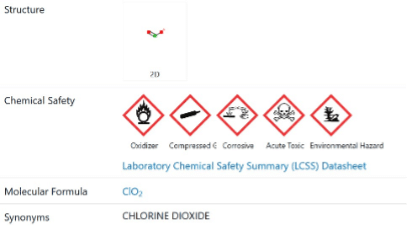- Chlorine dioxide is used for bleaching and slime control in pulp mills because of its strong reactivity and oxidizing capacity.
- Due to the safety and health risks to mill personnel and neighborhoods, chlorine dioxide must be handled carefully to prevent casualties and protect mill equipment and infrastructure.
- Regular inspections, gas detection, maintenance, and protocol updates can ensure a proactive approach to safety, reducing the risks associated with chlorine dioxide handling.
Chlorine dioxide is widely used in the pulp and paper industry, but there are potential risks associated with its use. Safety managers should know how to keep emissions under control to mitigate these risks. Gas detection is one of the crucial parts of the safety protocol. Learn more about the pulp industry’s risks and strategies for handling chlorine dioxide.
Chlorine Dioxide Use in Pulp Industry
Chlorine Dioxide is used in the pulp industry primarily for two reasons- for bleaching and as an anti-slime treatment.
Bleaching agent: The bleaching of wood pulp is a chemical process aimed at lightening its color for paper production, focusing on enhancing whiteness. Chlorine dioxide (ClO2) treatment is preferred over chlorine bleaching due to its environmental benefits in kraft pulp mills. Chlorine dioxide virtually eliminates dioxin discharges, addressing environmental concerns associated with traditional chlorine bleaching.
It selectively targets lignin’s phenolic groups, rapidly reacting to brighten and solubilize lignin without affecting cellulose fibers. This process increases yield and results in higher-strength bleached pulp.
Slime control: Paper mills face challenges with slime-forming microorganisms because they provide nutrients, warmth, and moisture that promote the growth of several bacteria, fungi, and algae. These microbes lead to various issues, such as spoilage of materials, production losses, and quality reduction.
Chlorine dioxide is an ideal biocide due to its algaecidal, bactericidal, and fungicidal properties. It operates across a wide pH range, allowing for efficient cleaning at low dosages. Thus, chlorine dioxide is suitable for integrated wastewater treatment in paper mills. Moreover, it disinfects clarified wastewater and controls odors in paper mill sludge during anaerobic fermentation.
Chlorine Dioxide Use Concerns
Though better than chlorine, chlorine dioxide used in pulp industries is considered a severe threat to mill workers and the neighborhood.
An Environment America analysis found that “Risk Management Plans” submitted to the EPA by pulp and paper mills show the wide vulnerability zone for chlorine dioxide. It was estimated that a single mill can endanger 600,000 in Tennessee to 1.2 million people in Ohio, depending on population.
The US has 58 pulp and paper mills using and storing chlorine dioxide onsite, so several million people are considered at risk. Therefore, there is a need to maintain and expand public access to essential information about chemical use and hazards at individual facilities.
This information is crucial for workers and communities to evaluate, understand, and respond to potential chemical threats. In addition, pulp mills should switch to chloride-free and safer technologies, if feasible, to prevent harm through accidents and leaks, which are not uncommon.
For example, in 2000, in France, an accident in the chlorine dioxide generator led to a gas expansion and an explosion. Though the chlorine dioxide emissions were contained, ClO2 levels peaked at 35 ppm for a minute. While there were no human casualties, equipment and building damage worth 150,000 Euros did occur.
Two leaks, one through a pipe gasket and the second triggered by a power outage in Florida, USA, released unknown amounts of ClO2 without causing any harm or damage, and workers were able to resume work some hours later.
The mills that continue to use chlorine dioxide must use scrubbers to remove it from the mill tail gases to prevent harming neighborhoods. The mills are also required to monitor and control air emissions within the mills to protect workers and ensure chlorine dioxide levels are below strict regulatory standards set by each country.
The regulations vary worldwide. However, global trends favor lowering the permitted emission levels to recognize health and safety concerns.

Figure 1: Chlorine dioxide properties. (Image credits: https://pubchem.ncbi.nlm.nih.gov/compound/Chlorine-Dioxide)
Safety and Health Concerns
Several properties of chlorine dioxide make it a concern.
Chlorine dioxide is a yellow to reddish-brown gas at room temperature and pressure. In its gaseous form, it has a characteristic chlorine-like odor.
Chlorine dioxide is a powerful oxidizing agent that readily reacts with reducing agents. It can react explosively with certain materials, so handling and storage require caution. Chlorine dioxide is selective with organic compounds in its reactions, will react with specific compounds, and does not form harmful byproducts in some cases.
Chlorine dioxide is a relatively unstable compound, and it does not typically exist as a pure gas due to its tendency to decompose. Therefore, it is often generated onsite as needed. Chlorine dioxide can decompose into chloride ions and oxygen, especially in the presence of light or specific catalysts.
Safety Issues
The safety issues of using chlorine dioxide due to its reactivity and oxidizing powers are as follows:
- Explosive: In certain conditions, chlorine dioxide can form explosive mixtures with air.
- Fire Hazard: Its strong oxidizing properties pose a fire and explosion hazard in the presence of combustible materials.
- Corrosion: Chlorine dioxide is corrosive to certain materials. Equipment used in the production and handling of chlorine dioxide must be made of corrosion-resistant materials to prevent damage and maintain the integrity of the systems.
- Environmental hazard: Chlorine dioxide can decompose quickly and react with impurities in the pulp to form chlorinated organic compounds, harming the environment. Effluent treatment processes are necessary to manage and minimize the environmental impact, especially on aquatic organisms.
ClO2 poses particular risks during storage, transportation, and handling. There is a risk of leaks or spills during these processes.
Health Effects
Chlorine dioxide can be toxic if not handled properly. Exposure to high concentrations through inhalation or ingestion can have acute and chronic effects.
Acute effects that occur immediately include the following:
- Contact with ClO2 irritates the eyes and skin, leading to eyes watering and halos around light.
- Inhalation irritates the nose and throat, resulting in wheezing and coughing. Lung irritation leads to shortness of breath and, in case of high gas levels, pulmonary edema or fluid buildup.
Chronic and repeated exposure to ClO2 can have long-lasting effects such as:
- Limited evidence indicates ClO2 may damage the developing fetus, and there is a need for caution during pregnancy to avert reproductive effects.
- Respiratory problems: Chlorine dioxide could lead to bronchitis with symptoms such as cough, phlegm, and shortness of breath.
Regulatory Compliance
Strict regulations govern the use of chlorine dioxide in industrial processes, and pulp mills must comply with environmental and safety standards. Failure to comply with regulations can result in legal consequences and fines.
In the US, the emission limits set by various agencies are as follows:
- Occupational Safety and Health Administration (OSHA) permissible exposure limit (PEL), which is legally applicable, is averaged over an 8-hour work shift at 0.1 ppm (parts per million).
- The National Institute for Occupational Safety and Health (NIOSH) recommended an exposure limit (REL) over a 10-hour work shift of 0.1 ppm. Short Term Exposure Limit (STEL) should be below 0.3 ppm during any 15-minute work period.
- American Conference of Governmental Industrial Hygienists (ACGIH) also recommends an exposure limit of an average of 0.1 ppm over an 8-hour workshift and an STEL of 0.3 ppm.
Local environmental regulations may govern emissions into the air or water.
Safety Protocol
To ensure that the ClO2 limits stay within permissible levels, pulp mill owners can take several steps that could include but are not restricted to the following:
Gas Detection: Monitor gas levels in the tail gases and within the mill premises constantly. A mixture of fixed and portable gas sensors will be necessary.
- Integrating fixed sensors with software like SCADA (supervisory control and data acquisition) will allow detection, data collection, and trend analysis for controlling processes and identifying risks.
- Portable gas sensors like Interscan’s GasD 8000 Series Portable Gas Analyzers should be used by staff going into areas suspected of leaks and spills or in confined spaces for protection. Interscan offers three options for estimating gas levels in less than one second: audio and visual alarms and data logging and storage. The measuring ranges are 0-1000 ppb (parts per billion), 0-20 ppm, and 0-2000 ppb, with a resolution of 1 ppb, 0.01 ppm, and 1 ppb, respectively.
Alarm Systems and Evacuation Procedures: Install alarm systems to warn of leaks and regularly conduct evacuation drills. Establish assembly points and communication protocols for emergencies.
Safe handling and storage: Develop and enforce clear standard operating procedures (SOPs) for handling, storing, and transporting chlorine dioxide. Utilize engineering controls like ventilation to minimize exposure and implement preventative measures against accidental releases.
Emergency Response Plans: Establish detailed plans for containment, cleanup, and evacuation in case of accidental releases.
Personal Protective Equipment (PPE): Specify and require the use of appropriate PPE, ensuring proper fit, training, and maintenance.
Training and Awareness Programs: Provide comprehensive training for personnel, including regular safety drills to reinforce emergency response procedures. Promote a culture of safety through ongoing awareness programs.
Mitigating Chlorine Dioxide Risks
The pulp industry must implement safety measures, including chlorine dioxide detection, to mitigate gas risks. Check this NJ Health resource for further information on safety protocols and remedial steps in case of accidents. Additional ongoing research and development aim to improve chlorine dioxide use’s safety and environmental impact in the pulp and paper industry.
Written by:
 Vijayalaxmi Kinhal
Vijayalaxmi Kinhal
Science Writer, CID Bio-Science
Ph.D. Ecology and Environmental Science, B.Sc Agriculture
Sources
ARIA. (2000, November 20). Leak with chlorine dioxide explosion. Retrieved from https://www.aria.developpement-durable.gouv.fr/accident/19261_en/?lang=en
Chlorine dioxide hazard summary – the official web site for the state. (n.d.-a). https://nj.gov/health/eoh/rtkweb/documents/fs/0368.pdf
Environment America. (2007, August 1). Pulp Fiction: Chemical Hazard Reduction At Pulp And Paper Mills. Retrieved from https://environmentamerica.org/resources/pulp-fiction-chemical-hazard-reduction-at-pulp-and-paper-mills/
Gan, W., Ge, Y., Zhong, Y., & Yang, X. (2020). The reactions of chlorine dioxide with inorganic and organic compounds in water treatment: Kinetics and Mechanisms. Environmental Science: Water Research & Technology, 6(9), 2287–2312. https://doi.org/10.1039/d0ew00231c
Garcia, D. ( 2014, May 29). Chlorine dioxide leak from GP’s Perry, Florida, Buckeye pulp mill, soon to be renamed Foley Cellulose Mill, causes no injuries, thought to have resulted from earlier power outage; company will investigate cause of leak, amount of gas released. Retrieved from https://www.industryintel.com/public2:news/read/4032779640
Häggström, K., Gunnarsson, M., Bremert-Jirholm, K., and Simic, N. (2019). Method for analysis of ClO2 and Cl2 air emissions from pulp mill. Nordic Pulp & Paper Research Journal, 34(1): 19–27
ILO Encyclopaedia of Occupational Health and Safety. (2011, March 28). Bleaching. Retrieved from https://www.iloencyclopaedia.org/part-x-96841/paper-and-pulp-industry/major-sectors-and-processes/item/848-bleaching#PPI_table3
Ni, Y. (1992). A fundamental study of chlorine dioxide bleaching of kraft pulp. Retrieved from https://escholarship.mcgill.ca/downloads/fn107077p
Pathak, P., Kumar, V., Bhardwaj, N. & Sharma, C. (2021). Slime control in paper mill using biological agents as biocides. Physical Sciences Reviews, 6(6), 149-173. https://doi.org/10.1515/psr-2019-0049


